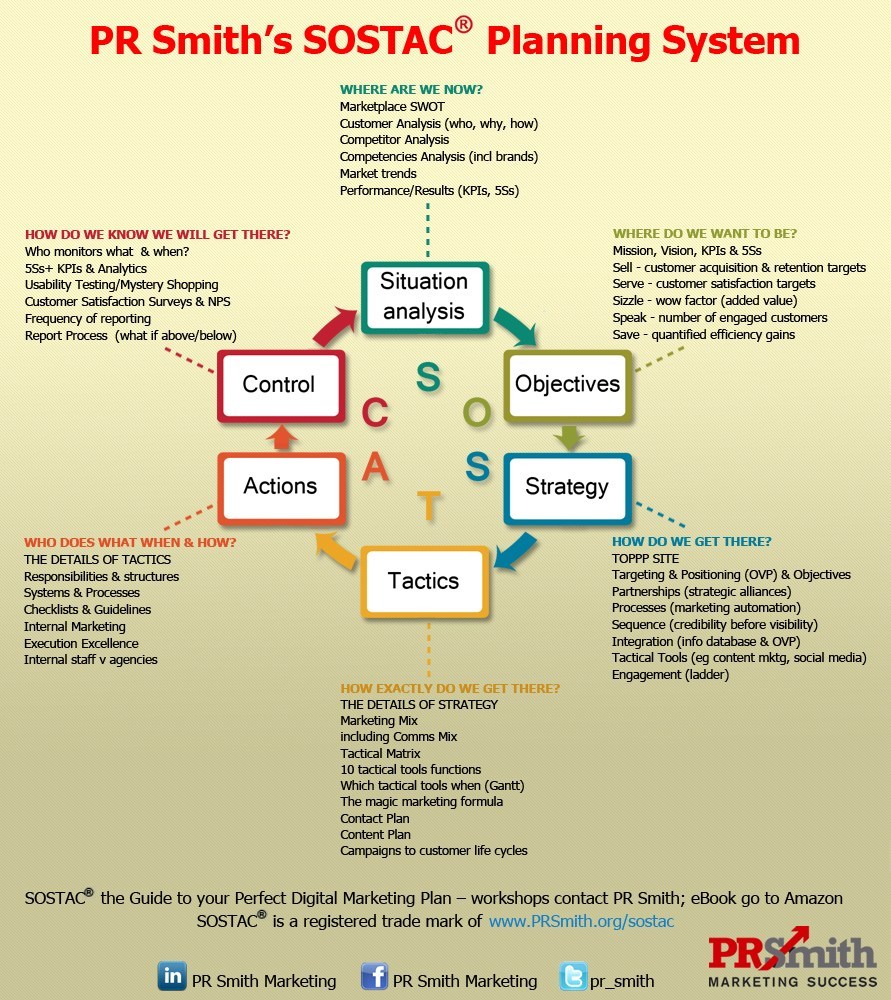I will explain the 6 easy steps of Marketing planning from PR Smith’s SOSTAC® Plan with examples. In the end, I will also share some important info-graphics explaining how the model can be used in digital marketing.
Table of Content
- What does SOSTAC® stand for?
- Why Use PR Smith SOSTAC® Marketing Planning Model?
- The 6 Easy Steps of the SOSTAC® Model
- Benefits of Paul R Smith SOSTAC® Marketing Planning Model
- Using SOSTAC® Planning Model in Digital Marketing
PR Smith SOSTAC® Marketing Planning Model is a management tool designed to help managers create effective marketing strategies and campaigns. It can be a good planning companion and provides a solid road map to help you achieve business objectives. I am going to focus more on marketing planning using SOSTAC planning framework.
However, the model might be too simplistic in its approach as every entrepreneur or marketing manager faces a unique business situation. To overcome this challenge, one can customize the model and can create a SOSTAC® plan as per the business requirements.
What does SOSTAC® stand for?
SOSTAC stands for Situation, Objective, Strategy, Tactics, Actions, and Control. These six concepts make up the SOSTAC® model and this article would explain them as 6 easy steps in the next section. Most managers are familiar with management concepts used in the model but they often struggle to increase the productivity of their team. Often, bad planning and execution lead to missing targets and that is why we need to utilize the model.
SOSTAC® is a practical tool that facilitates a manager in the planning room. It is supposed to make your life easy as a manager and give you a solid direction. After all, it is a paid tool, it must deliver on its promise.
Here are the 6 easy steps one by one explained in light of management concepts.
6 Easy Steps of the SOSTAC® Model (with examples)
- Situation
- Objective
- Strategy
- Tactics
- Actions
- Control
- Situation
If you are a manager or an entrepreneur, you know very well that situation analysis is a complex and demanding process. Often there are no clear answers, and you might have to rely on your guts as a last resort.
When a firm is faced with uncertainty and it is hard to choose from available options. You’ll have to do a complete situation analysis. The process of Situation analysis involves external and internal environment analysis. It is often a troika: the organization’s resources(strength), the opportunity outside, and the market situation.
Due to the changing business environment, you might be losing a lot of business. You need to figure out the appropriate but timely response. As a manager/entrepreneur, your task is to find the right fit based on the firm’s capacity and resources to gain the desired market share. Sometimes, you might find an opportunity but you don’t have the team (resources/skills) to take advantage of.
That’s what you need to figure out in a situation analysis- a strategic fit-out of the troika. Thus, the situation analysis makes up an important step in marketing or business planning.
Example: You would like to build a website. Here is what the situation looks like.
The current online market is tough and competitive. Growing a website is a challenge. Giants like Facebook, YouTube, Twitter, LinkedIn, Medium, etc own most of the traffic online. Some people might even claim that websites are dead now or they argue that at least it is the case mostly with the new ones.
They argue that there are a few big websites ranking high in search engines for every popular or profitable keyword. How can you rank your websites against the giant internet companies or authority websites with deep pockets? In other words, you will make a website but no one will find it.
There are always naysayers. Don’t worry about it. Yes, it is true that building a website is difficult but it is still working. However, in order to build a profitable website, You need to ask yourself some important questions( the situation analysis):
How much do you want to spend? Do you have a team to compete with big websites on the topic of your interest? Are you going for a niche?
If you can find the fit, go and build your website. By the way, websites are not dead but the way you have to do grow them now has changed. You see when the going gets tough, most people would exit the website market, and it is good news for those who would like to stay the course.
Depending on the industry & your business, you can begin with situation analysis as part of business or marketing planning.
(Note: PESTLE and SWOT can also be useful to execute a situation analysis.)
2. Objectives
Once you do a good situation analysis you are in a better position to decide on the objectives. These objectives(goals) should be both short and long-term. To make the objectives clear to your team and somewhat inspirational, it is recommended that you use the SMART approach.
SMART stands for Specific, Measurable, Assignable, Realistic, and Time-related. If you make your objectives according to the SMART framework of management, your team is likely to have optimal performance. For a quick start on SMART, you can also take a look at SMART criteria and George T. Doran
Example: The website in 12 months: 30,000 monthly visitors, Revenue: $1000/Month. You can also specify traffic by region.
3. Strategy
Strategy is a plan that would tell your team how they would get to their goals or objectives. Simply put, Strategy is your personal or team’s answer to the question “How”.
However, a strategy should be based on differentiation, otherwise, you would have no competitive advantage. Hence strategy is a different and better approach.
In other words, we can say the strategy is a different but better answer to the question of “How is it done? How do we create the customer value? How do we create the customer experience?” etc.
Example: For the website, strategy can be based on content marketing to create a brand in a niche with WordPress CMS.
4. Tactics
These are specific or detailed actions that your company needs to take to execute the strategy. Tactics are the details of a strategy. The situation analysis above should also inform you which tactic to select.
The use of tactics also depends on the nature of a business and its leadership style. An ambitious entrepreneur/leader would go more for a frontal attack requiring aggressive tactics. It means a lot more spending on the promotion of a business.
Examples: To build the website, the business can opt for Email marketing, Google Ad Campaigns (PPC), and sales funnel as tactics.
5. Actions
This step of SOSTAC® requires you to align and deploy your team efficiently to implement the tactics.
Simply ask:
Who is going to do What and When?
Example: You can assign the tasks to an in-house team or can hire someone from the market to help you execute your email marketing plan or PPC for the website. Sometimes, it is just better to find a highly specialized agency to run the email marketing or online ads campaign for you.
6. Control
How can you control and measure the processes? This is where you can assign KPIs and create a system of accountability at the individual and team levels. It is an internal management issue. Your objective is to monitor the performance of your team and get timely feedback to correct it.
It is a lot easier to measure an online marketing campaign. For example, in the case of a website you have many measurement tools available at your disposal. Such as google analytics, Hubspot’s tools, etc. However, traditional marketing communication programs are difficult to measure. You can always get a research firm to help you out with an audit survey if you can afford to do so.
Benefits of Paul R Smith SOSTAC® Marketing Planning Model
The model provides a clear and easy method of marketing planning. It is easy to implement and apply to the marketing processes. If applied the right way, you should be able to get a positive marketing or business outcome with SOSTAC® Planning. However, you’ve to pay for the tool to get it.
Using SOSTAC® Planning Model in Digital Marketing
Please, take a look at the images from PR Smith’s SOSTAC® below and I hope you find them useful.

Main Reference
SOSTAC® is a registered trademark of PR Smith. For more information on SOSTAC® Planning & becoming a SOSTAC® Certified Planner visit www.SOSTAC.org.

